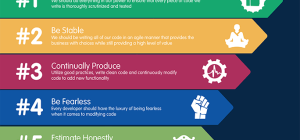 There are several steps to effectively develop enterprise construction project management software. Custom construction software is widely used to streamline the project management process for contractors, site managers, and owners. Of course, these solutions are vital to maintain a working budget, maximize quality, and keep teams on schedule. In fact, the best enterprise software products help users guarantee a safe work environment on complex building, demolition, and redevelopment projects. As an experienced software developer, it is highly-important to understand how this technology works, and exactly what it entails. This way, you can launch, promote, and profit from your very own software product. To help you get started, read on to learn about how to develop enterprise construction project management software.
There are several steps to effectively develop enterprise construction project management software. Custom construction software is widely used to streamline the project management process for contractors, site managers, and owners. Of course, these solutions are vital to maintain a working budget, maximize quality, and keep teams on schedule. In fact, the best enterprise software products help users guarantee a safe work environment on complex building, demolition, and redevelopment projects. As an experienced software developer, it is highly-important to understand how this technology works, and exactly what it entails. This way, you can launch, promote, and profit from your very own software product. To help you get started, read on to learn about how to develop enterprise construction project management software.
Plan Your Key Features
First and foremost, plan the key features that your enterprise construction software will contain. Project management software products typically include several advanced features by default. At a minimum, your system should be capable of performing material cost estimation, project design, and bid management. In addition, build-out capabilities for scheduling, field service monitoring, and safety. For construction project managers that manage larger teams, job costing and timesheet tracking functionality will additionally prove beneficial. Other important features to consider document control, accounting, and customer relationship management (CRM). Certainly, outline the core features to build in your enterprise construction project management software.
Set Up Your Tech Stack
Next, set up your tech stack with the best programming tools and resources for enterprise construction software development. At a minimum, leverage development tools to better control the custom software compilation process, such as Docker CMake. Leveraging this functionality, you can run different virtual operating systems (OS) within a Mac OSX, Linux, or Windows machine. Naturally, this is largely beneficial to automate continuous integration (CI) procedures, reproduce build environments, and maximize productivity. Moreover, programming with CMake empowers you enable automatic cross-platform discovery and configuration. Surely, setting up your tech stack is a fundamental step to develop enterprise construction project management software.
Select A Coding Language
Once you have your tech stack assembled, select a coding language. Some of the most popular frameworks for software development include Java, Ruby, and R. In addition, familiarize yourself with computer languages like Scala, JavaScript, and C#. If you are interested in learning a high-level, object-oriented coding architecture, you should additionally teach yourself Python. For programmers that want to build a specialized product for MacOS or Windows operating systems, it will additionally prove beneficial to learn Kotlin and Swift. In fact, some programmers are even teaching themselves Go, which enables better clarity and ease-of-use. Absolutely, choosing a coding language is essential to develop enterprise construction project management software.
Consider Your Pricing Structure
Now, you are ready to consider your pricing structure for your enterprise construction application. The price point of your software product will largely depend on your target audience. For example, systems for new and small businesses are often the most affordable. Products for mid-level and large enterprises, on the other hand, often come at a significantly higher cost. After all, these products are typically marketed to major corporations, local, and foreign governments. Similarly, consider adjusting your price based on the features you are providing. Software systems that are packed with innovative, valuable features typically come at a much higher cost. Indeed, evaluating your pricing structure is important to develop construction software.
Conduct Software Testing
At this point, it is time to conduct some software testing. Start off with basic forms of functional testing. This typically includes unit, integration, and sanity inspection. To further evaluate system functionality, run a beta acceptance, smoke, and regression analysis as well. Then, move on into non-functional forms of construction software testing. Typically, this includes recovery, reliability, compliance, and localization testing. Similarly, many expert programmers recommend performing an install, volume, security, and stress examination. Following these protocols, you can prevent catastrophic corporate emergencies and eliminate fatal errors in your product. Naturally, this is important to inspire stakeholder confidence and guarantee top-quality. Definitely, conducting software testing is an important step when developing enterprise construction project management software.
There are multiple highly-important steps to develop enterprise construction project management software. First off, plan the core features your software will contain. The best products contain features for accounting, bookkeeping, and financials management. This way, construction businesses can ensure their payment processes are smart and secure. Next, set up your tech stack with the best programming tools and solutions. Once you have done so, choose a reliable programming language. Now, you are ready to consider your pricing structure. At this point, it is time to conduct some thorough software testing. Follow the points highlighted above to learn about how to develop enterprise construction project management software.







